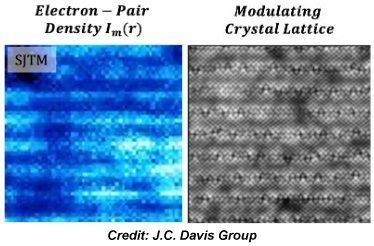

Reconciling SuperExchange with Planar Weight Disparity




Recently the JC Davis Group claimed to have confirmed the electron-coupling mechanism that facilitates high temperature superconductivity (HTSC) in the copper-oxides[1]. They assert that antiferromagnetic spin–spin interactions of electrons, in a process called “superexchange”, are the glue behind Cooper-pairing. Antiferromagnetism is a form of magnetic ordering where electrons align in a regular pattern of neighboring spins rotating in opposite directions (shown above). Although the net magnetic field is zero, such materials do have a magnetic moment at the quantum level - especially when a CuO2 oxygen atom loses an electron. And with magnetization comes inductance. (Hold that thought.)

In 2013 Superconductors.ORG (SCO) discovered that there absolutely must be a difference in the atomic weight of atoms positioned on opposite sides of the oxygen sites within a crystal lattice for that material to become superconductive. As a general rule, the greater the weight disparity, the higher the transition temperature (Tc) will be. This arrangement was dubbed "planar-weight-disparity"(PWD). Oscillations in the above Sr-O-Ca-O example are powered by lattice vibrations - the same thermal energy that causes resistance to appear in a normal conductor. Since heavy atoms vibrate slower than light atoms, PWD results in heterodyne compression of the interposed oxygen atoms along the C axis. This oxygen compression then affects the interatomic CuO2 "gap". This is the critical timing mechanism that administrates thermal energy within a superconductor. Without periodic compression (modulation) of the oxygen atoms in HTSC cuprates, superconductivity could not be established.

Then in 2014 further research by SCO found a direct correlation between the relative permittivity (dielectric constant) of sub-structures within the superconductor lattice and transition temperature (see graphic above). This means that electrostatic charges are at work in the electron-pairing process. And with electrostatic charges comes capacitance. When both inductance and capacitance are powered by thermal energy, a superconductor becomes a resonating electronic circuit. To illustrate this an equivalent electronic schematic has been placed beside an infinite layer structure at page top. Each component's function is noted and the arrow in the middle indicates a variable flow of electrons in sync with the PWD periodic compression rate.


E. Joe Eck
© 2022 - 2025 Superconductors.ORG
All rights reserved.
1. Shane M. O’Mahony, Wangping Ren, Weijiong Chen, Yi Xue Chong, Xiaolong Liu, H. Eisaki, S. Uchida, M. H. Hamidian, and J. C. Séamus Davis
 BACK to "News" page at Superconductors.ORG
BACK to "News" page at Superconductors.ORG